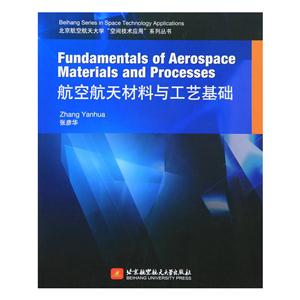航空航天材料与工艺基础
本书特色
[
《航空航天材料与工艺基础(英文版)》the main objective in this book is to present the fundamentals of materials science and processes used inaerospace engineering.the book starts with an overview of the structures of materials (chapter 1).chapter 2discusses the mechanical properties of materials and chapter 3 examines the solidification and phase diagrams.this is followed by chapter 4 through 6 are then devoted to the important engineering materials.the nextthree chapters (chapters 7 through 9) deal with the important field of materials processes, namely casting,deformation forming and welding.chapter 10 represents the materials and processes selection for aerospacestructures.
]
目录
introduction 0.1 evolution of aerospace materials 0.2 engineering materials and process 0.3 the materials process for aerospace structures chapter 1 structure of materials 1.1 introduction 1.2 atomic structure 1.3 atomic bonding 1.3.1 ionic bonding 1.3.2 covalent bonding 1.3.3 metallic bonding 1.3.4 van der waals bonding 1.4 crystal structure of metals 1.4.1 atomic arrangements in materials 1.4.2 metallic crystalline structures 1.5 crystal defects 1.5.1 point defects 1.5.2 linear defects—dislocations 1.5.3 planar defects 1.5.4 bulk defects 1.6 alloys and microstructure 1.6.1 alloying 1.6.2 phases 1.6.3 microstructure chapter 2 mechanical properties of materials 2.1 introduction 2.2 tensile properties 2.2.1 stress and strain 2.2.2 the tensile test 2.2.3 yield point 2.2.4 ultimate tensile strength 2.3 ductility and strain hardening 2.3.1 ductility 2.3.2 strain hardening 2.4 hardness 2.4.1 brinell hardness test 2.4.2 rockwell hardness test 2.4.3 vickers and knoop hardness tests 2.5 creep and stress rupture properties 2.5.1 creep properties 2.5.2 stress rupture properties 2.6 toughness 2.6.1 impact toughness 2.6.2 fracture toughness 2.7 fatigue properties 2.7.1 nature of fatigue failure 2.7.2 factors affecting fatigue life 2.7.3 s—n fatigue properties 2.7.4 fatigue crack growth rate chapter 3solidification and phase diagrams 3.1 introduction 3.2 phase diagram 3.2.1 common terms 3.2.2 isomorphous 3.2.3 eutectic 3.2.4 peritectic reaction 3.2.5 eutectoid 3.3 fe—c phase diagram and microstructure 3.3.1 fe—c phase diagram 3.3.2 fe—c alloys microstructure chapter 4ferrous alloys 4.1 introduction 4.2 classification of ferrous alloys 4.3 alloy steels 4.3.1alloying elements in steel 4.3.2 high—strength low—alloy (hsla) steels 4.3.3 high—alloy steels 4.3.4 stainless steels 4.3.5 tool steels 4.3.6 ultra—high strength steels 4.4 heat treatments 4.4.1 transformation diagrams 4.4.2 types of heat treatment 4.5 surface hardening 4.5.1 surface quenching 4.5.2 carburizing and nitriding chapter 5non—ferrous alloys 5.1 introduction 5.2 aluminum and aluminum alloys 5.2.1 physical metallurgy of aluminum 5.2.2 aluminum alloy designations 5.3 copper and its alloys 5.4 magnesium alloys 5.5 titanium and its alloys 5.5.1 development and application of titanium alloys 5.5.2 metallurgy of titanium alloys 5.6 superalloys 5.6.1 nickel and nickel alloys 5.6.2 cobalt—based superalloys 5.6.3 iron—based superalloys chapter 6 polymer, ceramic and composite materials 6.1 introduction 6.2 polymer 6.2.1 polymer structure and synthesis 6.2.2 polymer crystallinity 6.2.3 mechanical behavior of polymers 6.2.4 characteristics and typical applications of few plastic materials 6.3 ceramics 6.3.1 structures of ceramic materials 6.3.2 ceramic processing 6.3.3 general properties of ceramics 6.3.4 common structural ceramics 6.4 composite 6.4.1 composite structure 6.4.2 general types of matrix materials 6.4.3 reinforcements chapter 7 casting processes 7.1 introduction 7.2 sand casting 7.3 investment casting 7.4 die casting 7.5 permanent mold casting 7.6 centrifugal casting 7.7 casting techniques for single—crystal components 7.8 casting microstructure and defects chapter 8deformation forming processes 8.1 introduction 8.2 plastic deformation and formability 8.3 bulk deformation processes 8.3.1 forging processes 8.3.2 extrusion and drawing processes 8.3.3 rolling processes 8.4 sheet metal forming 8.4.1 blanking and piercing 8.4.2 bending 8.4.3 stamping or deep drawing 8.4.4 stretch forming 8.4.5 hydroforming 8.4.6 metal spinning …… chapter 9 welding processes chapter 10 materials selection for aerospace structural application references
封面

书名:航空航天材料与工艺基础
作者:张彦华
页数:329
定价:¥75.0
出版社:北京航空航天大学出版社
出版日期:2016-01-01
ISBN:9787512419247
PDF电子书大小:145MB 高清扫描完整版
